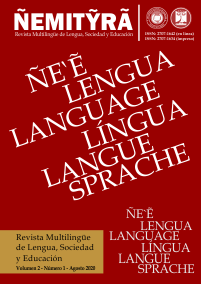Engaging facts: partnering with multilingual families
Palabras clave:
Culturally and Linguistically Diverse, Family Partnership, Family Engagement, Emergent Bilingual, Multilingual Learners, English Learner, Parent and Child Together Time, PACT Time, Early ChildhoodResumen
With pressing emphasis on the quality of early childhood preschool programs for children birth to age five, one quality assurance is for educators and family members to work together to foster the young child’s rapid development. Through reciprocal partnerships between educators and families, family members are empowered to continue with their contributions to their child’s education after they enter school. Through a U.S. Department of Education grant, pre-kindergarten and pre-service teachers took part in a Summer Institute Program focused on providing professional development on working effectively with multilingual children and their families. This study explored pre-kindergarten and pre-service teachers’ perceptions and experiences of implementing family engagement activities during the Summer Institute Program. The qualitative findings reported in this multiple case study were extracted from a larger mixed methods study of effectiveness of the overall professional development provided during the Summer Institute Program. During the program, family engagement opportunities included, though were not limited to, Parent and Child Together Time, family visits, and family engagement workshops. Findings for this study suggested that before the Summer Institute Program, teacher participants did not feel adequately prepared to work with families of multilingual students. Though several participants had previously implemented isolated parent involvement activities, few had authentically collaborated to form reciprocal partnerships with families, particularly those of multilingual students. Participants overcame initial and perceived challenges to partner with multilingual families through family engagement opportunities such as Parent and Child Together Time, which is the focus of this study. Furthermore, participants felt more comfortable in working with families of multilingual students after having participated in professional development on effective family engagement.
Descargas
Citas
Allen, J. (2010). Literacy in the welcoming classroom: Creating family-school partnerships that support student learning. New York, NY: Teachers College Press.
Bandura, A. (1989). Human agency in social cognitive theory. American Psychologist, 44, 1175-1184.
Brizius, J. & Foster, S. (1993). Generation to generation: Realizing the promise of family literacy. Ypsilanti, MI: High/Scope Press.
Bronfenbrenner, U. (1979). The ecology of human development: Experiments by nature and design. Cambridge, MA: Harvard University Press.
Bronfenbrenner, U. (1993). The ecology of cognitive development: Research models and fugitive findings. In R. H. Wozniak & K. W. Fischer (Eds.), Development in context: Acting and thinking in specific environments (pp. 3-44). Hillsdale, NJ: Erlbaum.
Bronfenbrenner, U. (1994). Ecological models of human development. In International Encyclopedia of Education. (2nd ed.) (Vol. 3). Oxford: Elsevier.
Center for Public Education. (2011). Back to school: How parent involvement affects student achievement (At a glance). Retrieved from http://www.centerforpubliceducation.org/Main-Menu/Public-education/Parent-Involvement.
Collier, S., & Auerbach, S. (2011). “It’s difficult because of the language”: A case study of the Families Promoting Success program in the Los Angeles Unified School District. Multicultura Education, 18(2), 10-15.
Denzin, N.K. (1989). Interpretive Interactionism. Newbury Park, CA: Sage.
Dobbs-Black, L., Renfro, J., Panzica, M., & Ritchie, J. (2012). Shelby County, AL, Toyota Family Literacy Program, research report. Unpublished manuscript prepared for the National Center for Family Literacy. Louisville, KY: National Center for Family Literacy.
Edwards, P. (2016). New ways to engage parents: Strategies and tools for teachers and leaders, k-12. New York, NY: Teachers College Press.
Epstein, J. (1995). School/family/community partnerships: Caring for the children we share. Phi Delta Kappan, 76(9), 701-712.
__________. (2001). School, family, and community partnerships: Preparing educators and improving schools. Boulder: Westview.
__________. (2011). School, family, and community partnerships: Preparing educators and improving schools. Boulder, CO: Westview Press.
Grant, K., & Ray, J. (2019). Home, school, and community collaboration: Culturally responsive family engagement. (4th ed.). Thousand Oaks, CA: Sage Publications.
Hatch, J. A. (2002). Doing qualitative research in education settings. Albany, NY: State University of New York Press.
Henderson, A. & Mapp, K. (2003). A new wave of evidence: The impact of school, family and community connections on student achievement. Austin, TX: SEDL. Retrieved from www.sedl.org/connections/resources/evidence.pdf
Hernandez, L., Zubov, L., Goddard, J., Vargas, M. & Hill, K. (2019). Culturally diverse families. In K. Grant & J.A. Ray, J.A. Home, school, and community collaboration: Culturally responsive family engagement (p.131-159). Thousand Oaks, CA: SAGE Publications.
Jacobs, K. (2004). Parent and child together time. In B.H. Wasik (Ed.), Handbook of family literacy (pp. 193-213). New Jersey: Lawrence Erlbaum Associates, Inc.
Koralek, D., Nemeth, K., & Ramsey, K. (2019). Families and educators together: Building great relationships that support young children. Washington, DC: NAEYC Books.
Levesque, J. (2013). Meta-analysis of the studies of high performing family literacy programs. National Center for Families Learning. Retrieved from: http://www.familieslearning.org/pdf/NCFL_Family_Engagement_Brief_.pdf
Mapp, K., Carver, I. & Lander, J. (2017). Powerful Partnerships: A Teacher’s Guide to Engaging Families for Student Success. New York: Scholastic.
Moll, L. (2014). L.S. Vygotsky and education. New York, NY: Routledge.
Stake, R.E. (1995). The art of case study research. Thousand Oaks, CA: Sage.
Yin, R. (2009). Case study research: Design and methods (4th Ed.). Thousand Oaks, CA: Sage.










